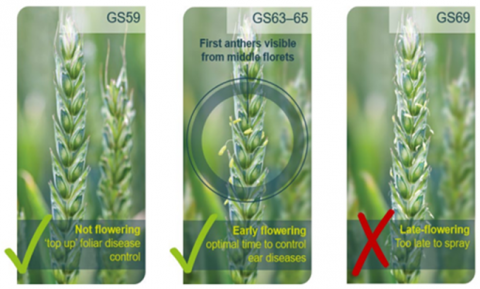Rebecca Joynt and Steve Ellis

Diseases in Winter Wheat
Rebecca Joynt
Septoria pressure is reported to be increasing following rainfall during May, with severity particularly high in early sown crops, susceptible varieties or where timing of sprays has been poor. Mildew continues to be present in many crops, especially where canopies are dense, and some active yellow rust infections are reported.
As ears emerge, growers should consider the target diseases and timing of T3 spray applications (Figure 1).
| ACTION - Consider requirements of T3 applications in winter wheat. |
Pests in Winter Wheat
Steve Ellis
Over the week 16-22 May average air temperatures were above the long-term average and as a result catches of grain aphid and rose grain aphid have increased again in the Rothamsted Insect Survey (RIS). There have still been no reports of thresholds being exceeded in crops. Thresholds are as below:
- Before GS61 – 50% of tillers infested
- GS 61 to two weeks before the end of grain filling 66% of ears infested
Full details of the catches from individual suction traps are available here
| ACTION - Continue to monitor crops for the presence of aphids but only treat if the threshold is exceeded. - Get the latest updates on aphid migration from Crop Action or the RIS Aphid bulletin. |
Orange wheat blossom midge (owbm) adults continued to be caught at all RIS trap sites over the period 16-22 May. To date we have had no reports of midges being seen in crops but it is important to check owbm-susceptible winter wheat varieties at the susceptible growth stage (GS53-59) for adult females during the evenings. Owbm-susceptible varieties of winter wheat crops are at risk until the early flowering stages are reached (average GS61 including secondary tillers across the field). Some crops are already beyond this stage and so no longer susceptible.
Logistically, it is impractical to monitor large areas of wheat potentially at risk in the limited time available. It helps if blocks of wheat crops can be monitored rather than many individual fields when midges start to emerge. Checking will enable higher-risk fields that may benefit from treatment to be identified. Group 1 and 2 wheats, and seed crops, should be made priorities for monitoring and need for owbm control.
Further information on this sporadic pest is available in AHDB Information Sheet 53 on guidelines for monitoring and control of orange wheat blossom midge .
| ACTION - Consider using pheromone traps during the period of adult emergence, to monitor for male owbm at emergence sites. - Consider monitoring midge numbers in wheat crops with yellow sticky traps. - Check wheat crops or blocks of crops for owbm during susceptible ear emerging/emerged stages on warm, still evenings. - Only apply a spray if the threshold is exceeded. In practice this equates to the emergence of a cloud of midges when the crop is parted. - Prioritise the need for spraying crops according to their value. The most valuable milling and seed crops should be considered as the highest priorities. |
